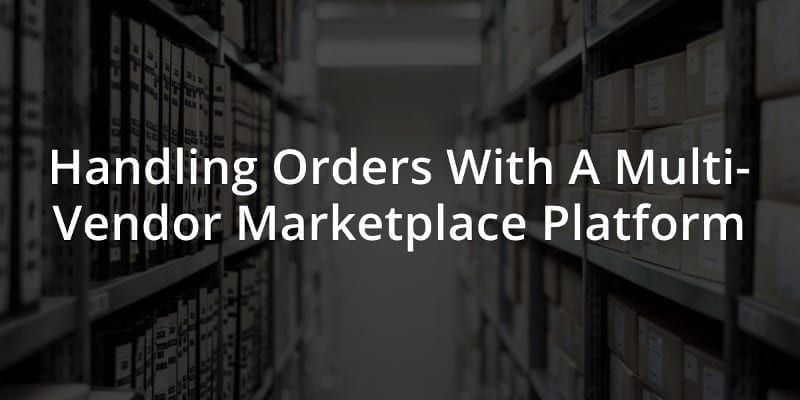Handling Orders With A Multi-Vendor Marketplace Platform
In 2017 Amazon shipped over five billion items worldwide only through Prime.
Besides the complexity of processing such a large amount of orders, another difficulty of order management is that online customers expect that they can buy products whenever, wherever, and however they want for a fee, according to the Accenture Study:
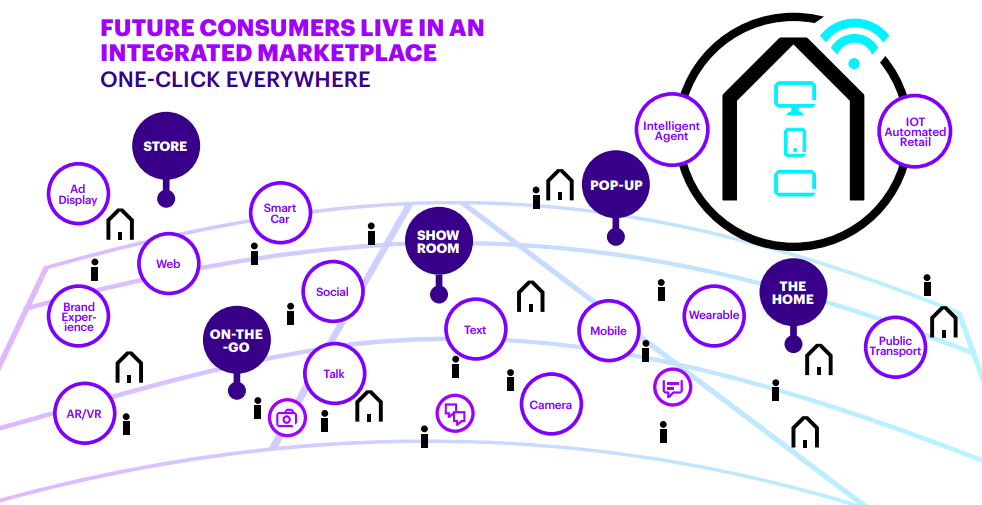
At the heart of a successful order handling is an efficient order lifecycle management, that embraces all steps from order placement and processing and online order handling charge to inventory coordination and shipping.
You may also be interested:
multi vendor marketplace software
1. Order Processing
Order processing starts when an order is placed and ends when it is shipped.
Processing time may take a few hours or a few weeks depending on the web marketplace platform type, the company business processes, and product: complex-to-make handmade items or fresh food.
Define an estimated order processing time and create guidelines for both online vendors and customers for them to be on the same page regarding their obligations and expectations, and to avoid conflict cases. Often, a manager of the order checks online free shipping and handling charges to inform a consumer.
Etsy online order handling time conditions:
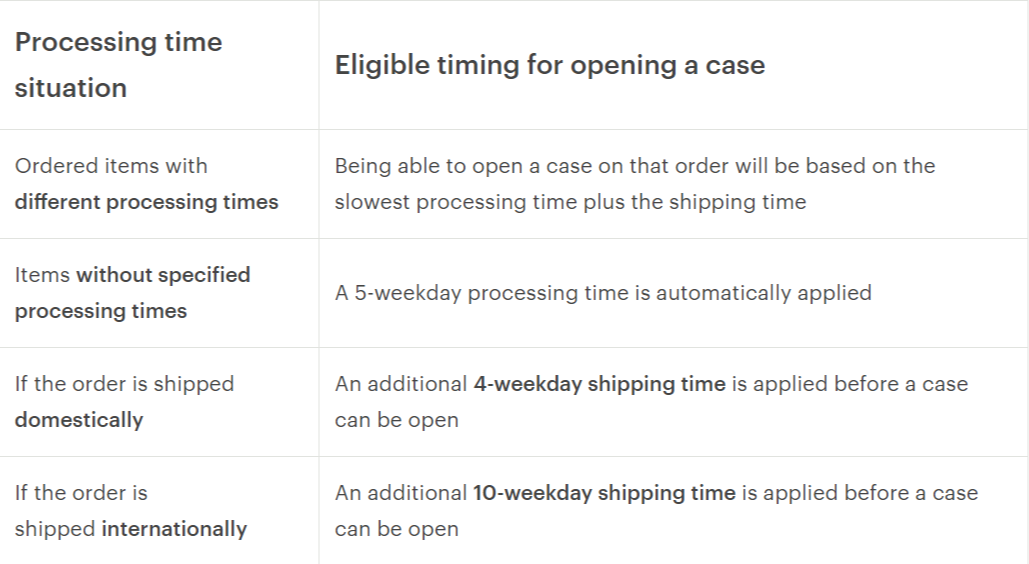
1.1 Receiving Orders
Provide to sellers of your multi-vendor company the ability to receive orders from different channels: smartphones, Social Media shops:
Online shoppers who have made an order on a smartphone:

Enable various ways of order receiving for vendors:
- incoming consumer requests “Buy in 1-click”: a consumer clicks the button on a product details page, and vendors see a new order with the “Awaiting call” status;
- the ability to create an order from the vendor panel;
- backorder or pre-order features;
- a standard checkout process: consumers add items to a shopping cart while continue shopping.
Enable integration between your company’s marketplace CMS and the vendors’ CRM and other systems for them to avoid manual order details transferring, and to enter them into the vendors’ business software automatically instead.
Define the details that should be captured when receiving orders and which suit your Internet multi-store company specific characteristic:
- consumer address and contact details;
- the ordered item description;
- payment, fee, and transaction details;
- your marketplace or vendors’ specific requirements.
Besides, provide the tools and guidelines to vendors and admins on how to manually check suspicious orders before they are processed, as the following:
- the number of orders placed by a consumer during a certain timeframe exceeds a certain amount;
- quantity of a single SKU ordered by one consumer exceeds a certain amount.
Also, enable an automatic notification for consumers that the order is received.
1.2 Order Payment Processing
There are detailed information on how to process fees in a marketplace system in our article, but the following components are specifically important in the order management context:
- checkout functionality must present order information to help consumers to conveniently pay a fee and complete a purchase;
- a convenient payment process from authorization to fraud detection to foster order fulfillment.
One of the main issues with fee processing is that one consumer may buy multiple products from different vendors, while you receive one collective order and a single cumulative amount as fee.
Provide consumers with the “add to cart” option and the ability to do the checkout only once: ensure that your CMS allows placing a single order while buying goods from several vendors.
In this way, two separate orders are created in the admin panel, and your online vendors see the order part that contains only the items that belong to them.
1.3 Order Management
Provide a separate panel with orders for each vendor, which is integrated to the main panel of your multi-vendor marketplace company website, for your vendors and admins to view all orders’ and fee data at a glance:
- the orders’ amount and the placement date;
- the fee amount;
- consumer’s data: name, phone number, address, the questions from clients;
- the time and place of delivery;
- the products that need restocking;
- the unpopular items that may need to be priced differently;
- real-time maintenance of inventory;
- the stage of the order fulfillment.
Besides, use those parameters for an advanced orders’ search, for vendors and admins to quickly find and filter the orders by a payment method, the fee amount, or a date.
Order statuses is another feature that helps to manage orders accurately:
- order list with statuses that can be changed manually and automatically;
- the ability to create new statuses that suit your business workflow, product type and the vendors’ needs.
Etsy order statuses changing steps:
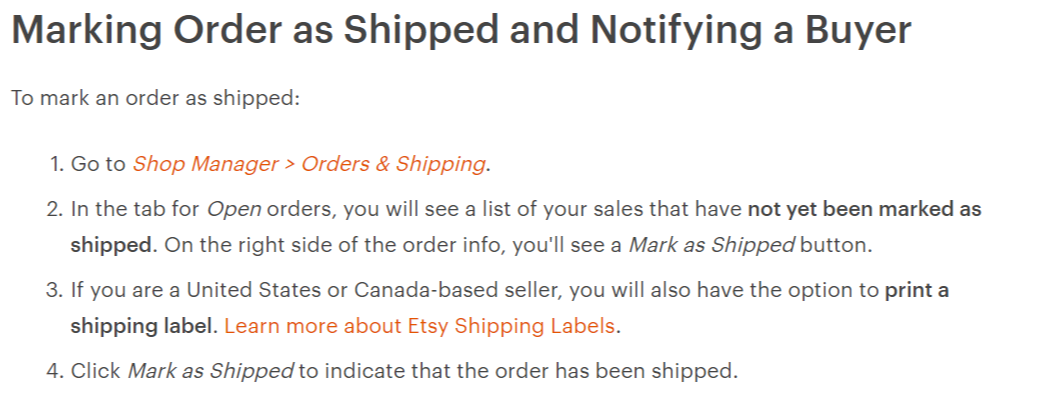
1.4 Communication with Customers
Keep your consumers informed by sharing the order processing details and sending regular automated email notifications about their order current status: received, dispatched, or in transit.
An e-Commerce Packaging Study shows that, more than half of online shoppers are negatively influenced by the poor order transparency:
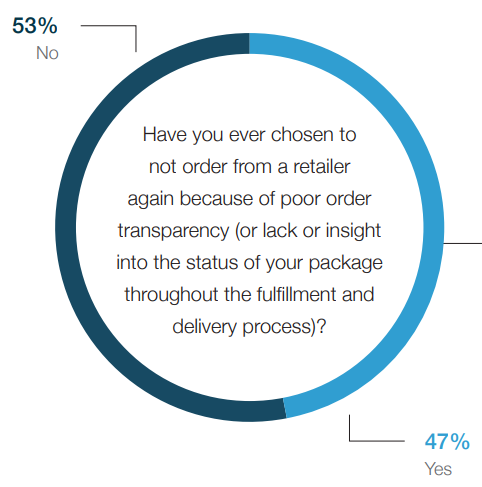
Thus, it is necessary to enable improved order tracking, the transparency of fees, and visibility during a fulfillment process.
Etsy track your order feature:
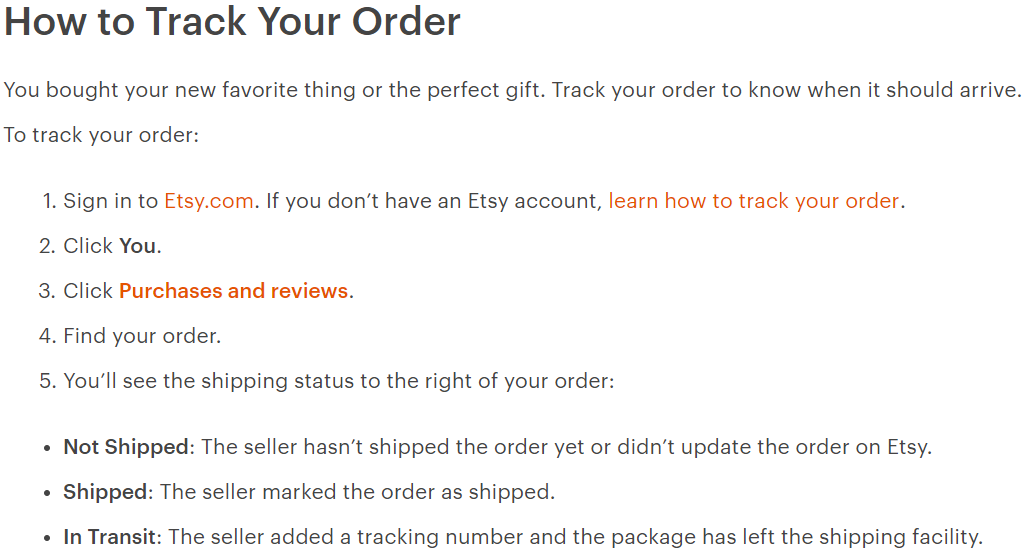
Take into account that online shoppers care the most about having information about the order when in transit.
Also, provide your virtual multi-vendor store consumers with the ability to ask all the questions that are connected to orders directly to vendors.
Etsy guidelines on how to contact a seller:
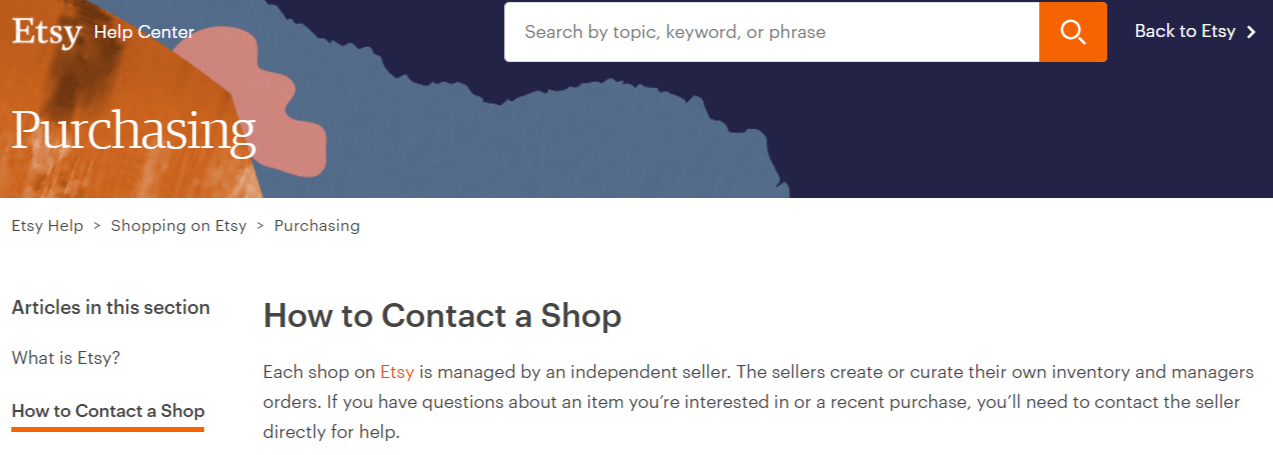
Consider web chat software to help consumers during the ordering process as well:
Online shoppers’ comfort level withusing chatbots:
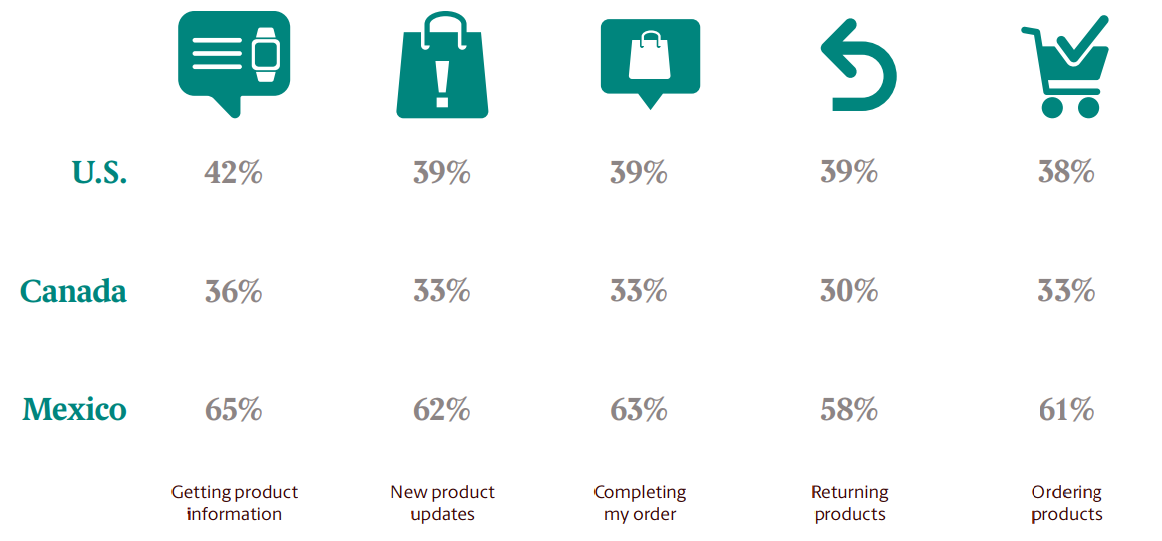
Besides, you can provide the tools that help clients manage orders by themselves:
- update the order and fee information;
- contact and address details;
- easily reorder previously ordered goods.
The Internet multi-store marketplace, the Etsy company, lets consumers to fix a wrong shipping address on order at each fulfillment stage: when it is shipped, not shipped, and during the order placement.
Also, enable the opportunity for consumers to report any order problems directly to your company’s marketplace CMS admins:
Etsy report a problem feature for buyers:
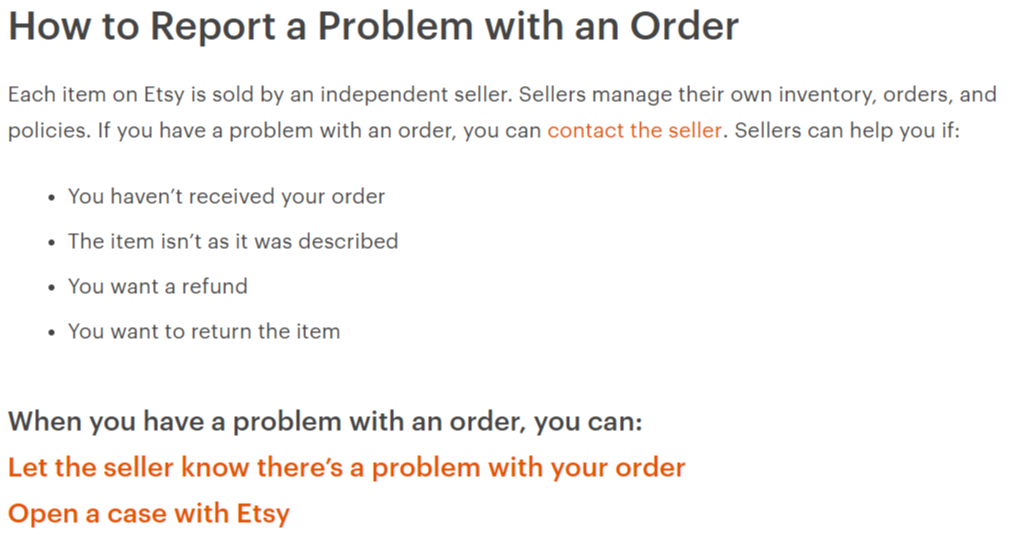
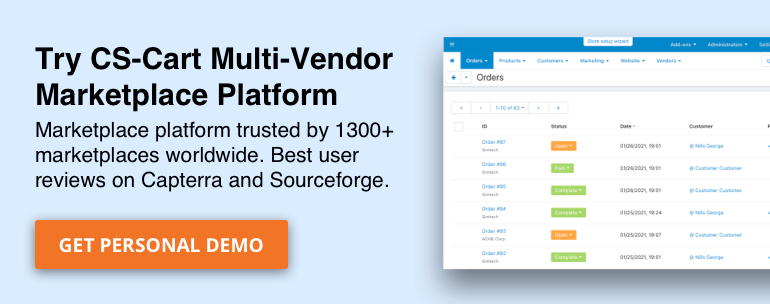
2. Order Fulfillment
Define the fulfillment workflow and requirements to your shipping and warehousing suppliers on the basis of your online multi-store shopping mall characteristics, such as the product type. In this case, the marketplace company warehouse often stores upserve.
A grocery web marketplace company should enable a much shorter fulfillment time and specific requirements for the ingredients’ storage, while digital goods don’t need warehousing at all, and the detail steps in downloading should simply be provided, like Etsy downloading a digital item guidelines.
The variety of the fulfillment options is important for both consumers and vendors as well:
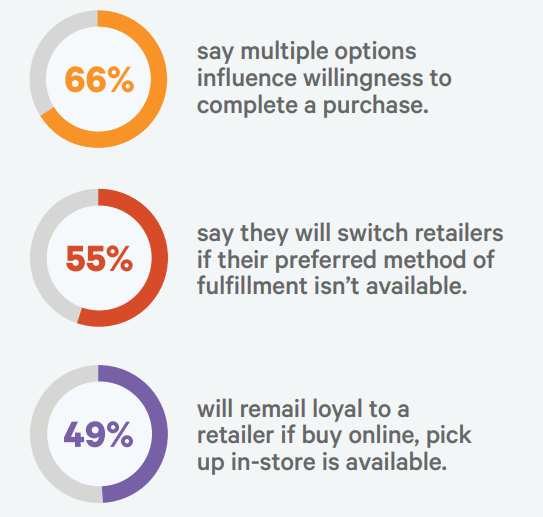
Research your consumers’ and sellers’ needs and expectations: the clients’ geo, if the local pickup is required, and all gaps in the fulfillment process from the consumer side.
On the basis of that, define the most suitable fulfillment options:
- offline stores if you carry omnichannel approach;
- vendors’ facilities;
- third-party logistics providers (3PLs);
- third-party offline stores that suit your online marketplace company concept.
The virtual multi-vendor store Etsy provides thorough fulfillment guidelines, and value-added services such as shipping labels, while the multi-vendor company Amazon created a comprehensive fulfillment ecosystem to its sellers:
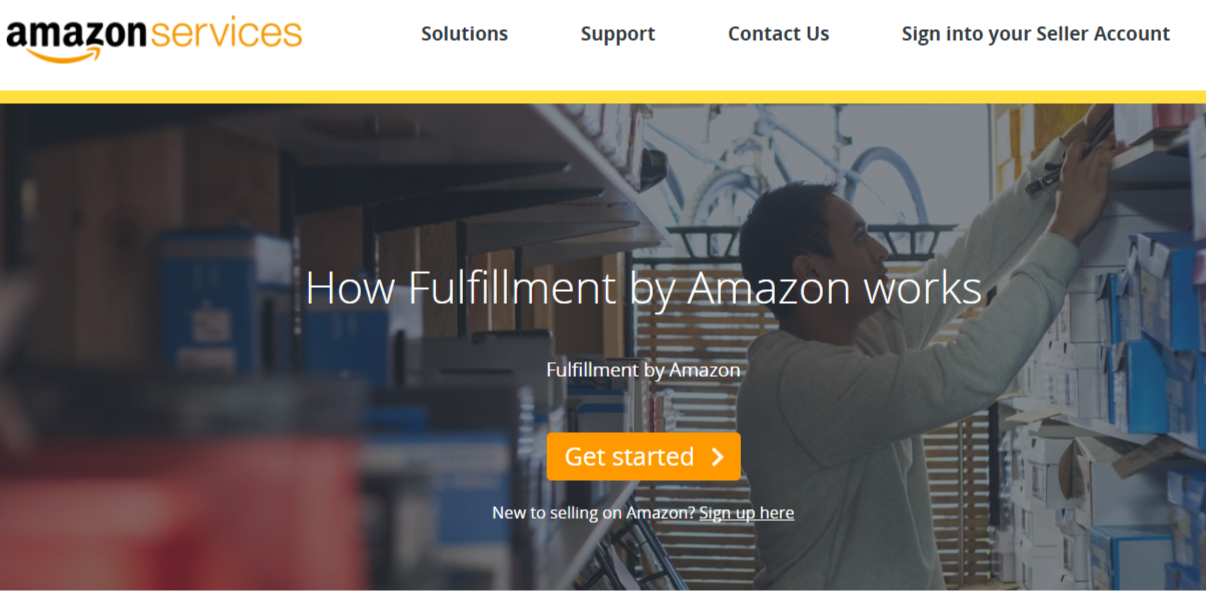
2.1 Order Warehousing
Whether your Internet multi-store company has its own warehousing capabilities, or you are using the third-party service, the following points influence the warehousing efficiency:
- inventory control: optimal inventory levels to reduce delays and backorders;
- warehouse capacity;
- order picking accuracy;
- internal order cycle time: how long it take an order to move through the distribution center;
- dock-to-stock cycle time: how fast the inventory is available for sale (not just unloaded from a truck while isn’t available for fulfillment).
Enable integration of the sellers’ business software, your company’s marketplace CMS and warehousing for vendors to check stock availability and for the orders’ data exchange.
The UPS Pulse of the Online Shopper study confirms that 58% of shoppers believe that the ability to view inventory availability as they search for products online is important to the purchase decision, and less likely to buy (even without shipping fee) if they can’t check it.
Etsy inventory availability:

2.2 Order Packaging
Define suitable packaging options for your vendors, product type, and the consumer preferences, such as gift-like packages. Consider taking a fee for packaging.
An e-Commerce Packaging Study claims that 40% of online shoppers are more likely to purchase from a retailer again if the order came in a gift-like or premium package, while 50% of buyers say that it makes them more likely to recommend the product to their friends. Usually, consumers are ready to pay a fee for gift-packaging.
Besides, check if vendors provide a guarantee that the packaging enables adequate protection for items: the multi-vendor company Amazon provides packaging services to avoid damaged delivery or other issues with packaging. Vendors can also offer this kind of service for an extra fee.
2.3 Order Shipping and Delivery
Shipping and delivery is the key order handling component.
e-Commerce Packaging Study on the accurate delivery importance:
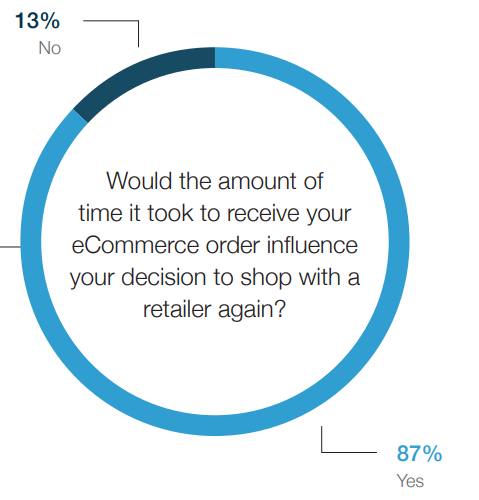
69% of online shoppers are less likely to shop with a retailer in the future if an order is not delivered within 2 days of the promised date, while 68% of online consumers expect delivery of their order within three days. Customers often prefer a free shipping without extra fees and they expect the delivery in time.
Research detailed expectations of your online multi-store shopping mall customers connected with the order delivery, and take into account the exact hours they want to receive an order and the amount of fee they are ready to pay for the delivery:
The online consumers’ expectations for next-day order shipping:

Provide your multi-vendor company sellers with the ability to view all the orders which have to be delivered, and establish a sorting system for your admins to see which vendors have not yet delivered their orders.
Also, consider your suppliers’ cut-off times, your shoppers’ locations, and integrate with a 3PL service provider that has a nationwide network of warehouses.
Take into account that the study shows that 67% of the virtual multi-vendor store customers would pay a bigger fee for the orders that are connected with a special occasion:
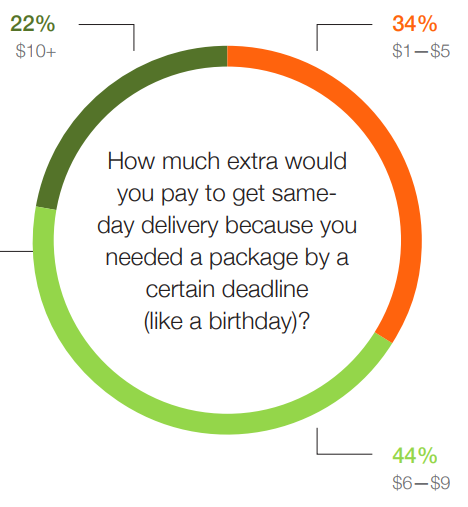
Besides the delivery time, research the information your customers prefer to have in connection with the order shipping:
- order shipment number and shipment method;
- tracking details;
- order status;
- date shipped and estimated delivery date;
- shipping fee.
Also, enable multi-address delivery from a single order: deliver to different addresses while a consumer pays a fee for a single purchase.
2.4 Order Returns Management
As the e-Commerce Product Return Statistics shows, 30% of all online orders result in returns.
Thus, returns’ handling is an important part of the order management process.
An efficient returns’ management embraces the following components:
- the simplicity of the returns’ processes;
- the speed with which fee refunds are provided;
- the ease with which incorrect or damaged goods are replaced or repaired without extra fee
Also, establish rules and define the information that Internet multi-store marketplace customers should provide for the order return:
- the item name, original package and documentation;
- the reason for the return;
- the location an item should be returned to.
Etsy returns policies:
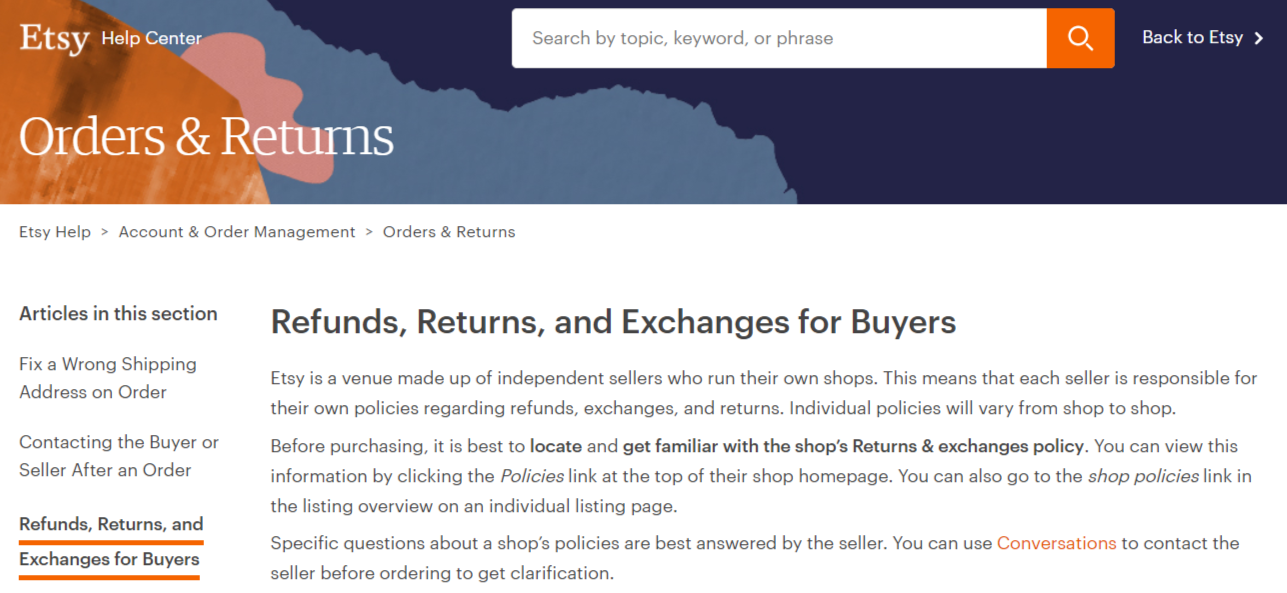
At the marketplace, each seller is responsible for their own policies regarding fee refunds, exchanges, and returns.
Define which returned items may be re-added to your inventory, and establish specific protocols for that process.
Simplify returns process by enabling online multi-store shopping mall customers to create returns online.
Besides, you can provide the necessary delivery, fee, and return documents when shipping an order.
Analyze returns and identify what items are being returned more often: you may find that smaller items are easily confused, or that packaging needs to be improved. You can offer extra packaging for a fee.
The top returns’ reasons:
- damaged items;
- the orders with the wrong item.
If refund is necessary, ensure that your online multi-vendor marketplace company provides the ability to indicate a fee refunded order which will only refund the fee by a specific vendor within a whole order, and not for all vendors.
Establish creative ways to support virtual sellers on each stage of the order management workflow.
The Flipkart Troops initiative puts students who are doing warehouse and supply chain management courses in touch with small- and medium-sized sellers for any extra help they might need in the warehouse during The Big Billion Days sale, when the order numbers go up drastically. This way, both parties benefit:


3. Order Workflow Mapping and Improvement
Get a clear overview of where your order processing starts and ends to identify gaps and improve the order handling velocity and efficiency.
The main points to consider:
- the ability to accept orders, payments, and a fee regardless of channel origin or currency;
- the optimal order’s route from warehouses to destination;
- the ability to update inventory levels across systems;
- the ability to track order fulfillment process for admins of a web marketplace company website, sellers and customers;
- a unified view of all order activity, and the detailed view of the order and customer details;
- integration with warehouses, shipping partners and vendors’ order management business software, like CRM;
- the ability to reduce the Internet multi-store company team workload by empowering customers with tools to manage their orders independently.
The following metrics help to measure the order workflow efficiency:
- total order cycle time: the average processing time from the point an order is placed to the point when it is shipped;
- perfect order percentage: the entire order is shipped to the customer, on time, with no damage, and with 100% accuracy in documentation;
- fill rate: a percentage of orders filled 100% complete to the total number of orders delivered.
With that said, the are two pillars that help to create an efficient order management workflow:
The streamlined order management processes: order placement and management, payment or fee withdrawal system, warehousing and packaging, inventory management, shipping and delivery, and post-delivery activities, such as order returns or exchanging;
A tech ecosystem that encompasses all order handling functions: the company‘s marketplace CMS that is integrated with the shipping partner software, CRM and payment and fee withdrawal systems to create a hub where the order data from various sources is stored and processed.

Yan Anderson is the Head of Content Marketing at CS-Cart with over 10 years of experience in the eCommerce industry. He's passionate about explaining complicated things in simple terms. Yan has expertise in building, running and growing eCommerce marketplaces. He loves to educate people about best practices, new technologies, and trends in the global eCommerce industry.
